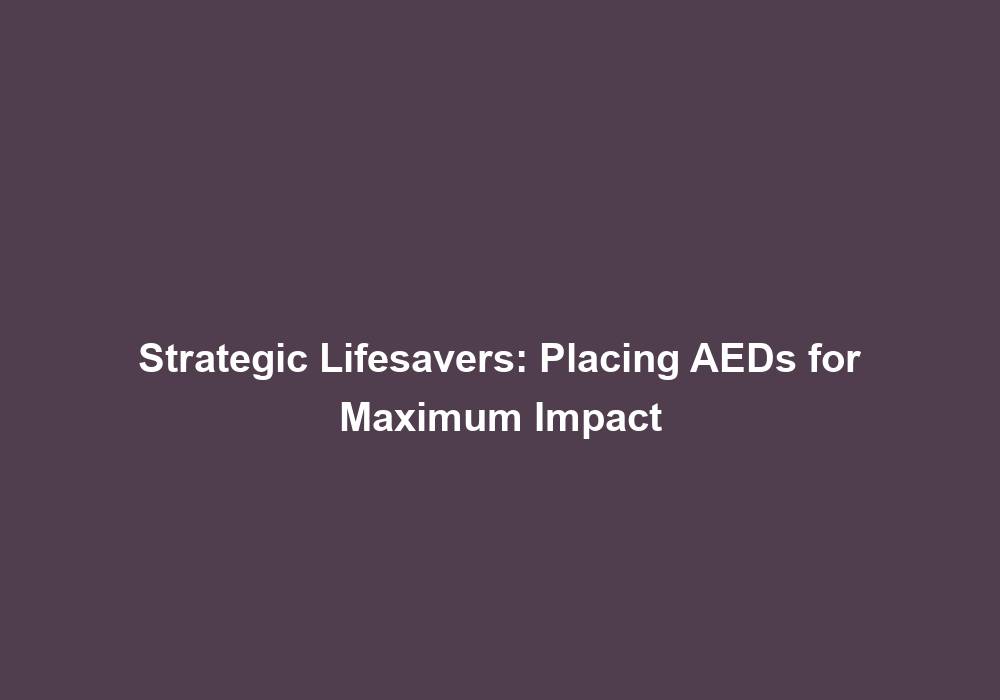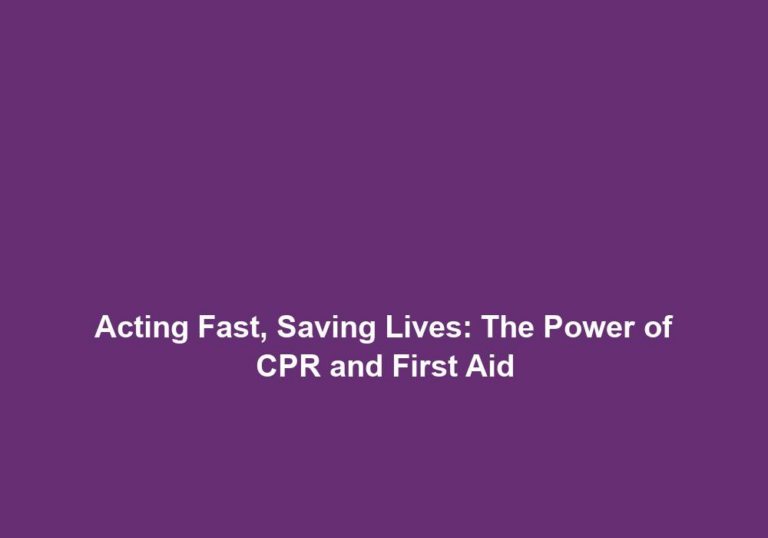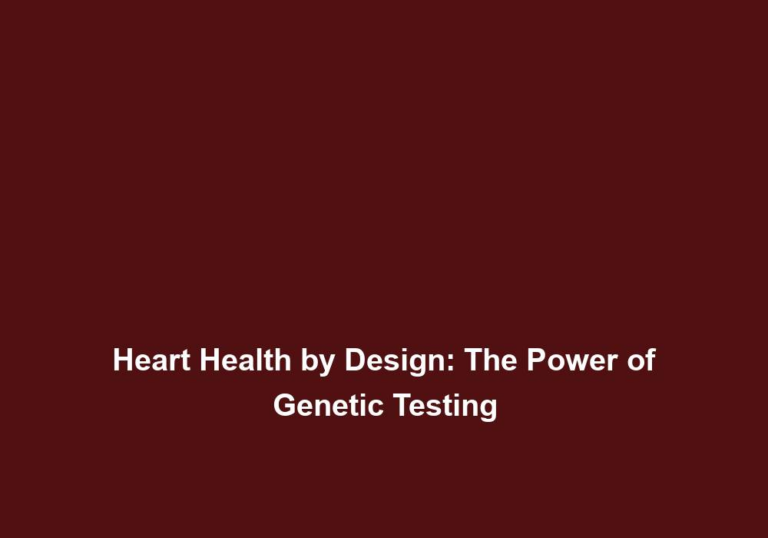Strategic Lifesavers: Placing AEDs for Maximum Impact
According to the American Heart Association (AHA), sudden cardiac arrest (SCA) is a leading cause of death worldwide, claiming millions of lives each year. However, the use of Automated External Defibrillators (AEDs) has proven to be a life-saving measure that can significantly increase the chances of survival. Strategic placement of AEDs in various locations can play a crucial role in maximizing their impact and saving more lives. In this article, we will explore the importance of AED placement and provide insights into strategic considerations.
The Importance of AED Placement
Quick access to an AED is vital in treating sudden cardiac arrest. AEDs are portable devices that deliver an electric shock to restore normal heart rhythm when someone experiences a sudden cardiac arrest. The faster an AED is applied, the greater the chances of survival. Therefore, the strategic placement of AEDs is crucial for prompt and effective response.
To ensure quick access during emergencies, AEDs should be placed in high-traffic areas. Locations such as airports, shopping malls, sports arenas, schools, and office buildings are ideal for AED placement. These areas experience a large number of people on a daily basis, increasing the chances of someone being present in case of an emergency.
Moreover, AEDs should be placed in visible and easily accessible locations. They should be installed in well-lit areas and prominently displayed with clear signage. Visibility plays a crucial role as it helps bystanders and responders locate the AED quickly, reducing response time. By ensuring AEDs are easily identifiable, individuals can swiftly retrieve and use them, potentially saving a life.
Strategic Considerations for AED Placement
- High-Traffic Areas
Placing AEDs in high-traffic areas can significantly increase their accessibility and effectiveness. Locations such as airports, shopping malls, sports arenas, schools, and office buildings are ideal for AED placement. These areas experience a large number of people on a daily basis, increasing the chances of someone being present in case of an emergency.
In addition to these locations, it is also important to consider placing AEDs in community centers, parks, and other public spaces where people gather. By having AEDs readily available in these high-traffic areas, the chances of bystanders quickly accessing and utilizing the devices increase, improving the overall response time.
AEDs should be placed in clear and easily identifiable locations to ensure quick access during an emergency. They should be installed in well-lit areas and prominently displayed with clear signage. Visibility plays a crucial role as it helps bystanders and responders locate the AED quickly, reducing response time.
Consider placing AEDs near entranceways, reception areas, or other highly visible spots within a facility. This ensures that individuals can easily spot the AEDs and retrieve them without wasting precious seconds searching for their location. Additionally, it is important to regularly check and maintain the visibility of signage to ensure it remains clear and easily readable.
- Proximity to High-Risk Areas
Identifying high-risk areas is crucial for effective AED placement. Places with a higher likelihood of cardiac events, such as fitness centers, swimming pools, and elderly care facilities, should have AEDs in close proximity. By strategically placing AEDs near high-risk areas, the chances of early defibrillation increase, leading to higher chances of survival.
Consider conducting a risk assessment of your facility or community to identify areas where cardiac events are more likely to occur. This can involve analyzing historical data, consulting with healthcare professionals, or considering the demographics and activities of the population in that area. By understanding the unique risks, you can strategically position AEDs to maximize their impact.
- Urban versus Rural Placement
When considering AED placement, it is essential to take into account the location’s urban or rural setting. In urban areas, where emergency medical services (EMS) have faster response times, AED placement can be more flexible. However, in rural areas with longer EMS response times, having AEDs in easily accessible locations becomes even more critical.
In rural settings, it may be necessary to strategically place AEDs in public areas that are further apart to ensure coverage across a larger geographic area. This can involve collaborating with local emergency services to identify optimal locations for AED placement. Additionally, considering the availability of trained individuals who can respond in rural areas is crucial for successful AED implementation.
- Accessibility 24/7
Cardiac arrests can occur at any time of the day or night. Therefore, AEDs should be placed in areas accessible 24/7. This includes ensuring AEDs are available in outdoor locations and considering their placement in areas where businesses operate beyond typical office hours.
In outdoor settings, it is important to provide weatherproof and secure AED cabinets to protect the devices from environmental factors and potential theft. Furthermore, collaboration with local businesses or organizations to ensure AED access during off-hours can greatly enhance the chances of timely defibrillation.
Along with strategic placement, it is crucial to provide proper training and increase awareness about the presence and usage of AEDs. Employers, facility managers, and community leaders should organize training sessions to educate individuals on how to use an AED effectively. This knowledge empowers bystanders to take immediate action and potentially save a life.
Training sessions should cover topics such as recognizing the signs of sudden cardiac arrest, activating emergency medical services, and performing cardiopulmonary resuscitation (CPR) in conjunction with AED use. By equipping individuals with the necessary skills and knowledge, they can confidently respond to cardiac emergencies and utilize AEDs effectively.
- Regular Maintenance and Monitoring
Ensuring the functionality and reliability of AEDs is essential. Regular maintenance and monitoring of AEDs should be carried out to ensure they are in proper working condition. This includes regular battery checks, pad replacement, and software updates. Additionally, having a system in place to track AED locations and maintenance schedules helps ensure their effectiveness.
Implementing a comprehensive maintenance program is crucial for maximizing the lifespan and performance of AEDs. This can involve establishing a schedule for routine checks, conducting regular inspections, and documenting any maintenance activities performed. By maintaining AEDs properly, you can ensure their readiness and optimize their life-saving potential.
Conclusion
Strategic placement of AEDs is vital for maximizing their impact and saving more lives. Placing AEDs in high-traffic areas, visible and easily accessible locations, and proximity to high-risk areas can significantly increase their effectiveness. Considering the urban or rural setting, ensuring accessibility 24/7, providing training and awareness, and regular maintenance are also crucial factors to consider. By implementing these strategic measures, we can enhance the chances of survival in cases of sudden cardiac arrest and make AEDs true lifesavers in our communities.







